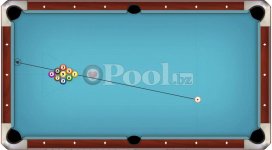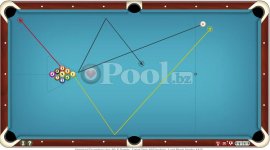Don't do it!
Watch Joe Tucker's
Racking Secrets video (which is really a 'breaking secrets' video).
It shows in great detail is why it's generally better to
break from the side in 9-ball.
The balls at the far left and right side of the rack drop very often if you break from the side.
Breaking near the center screws this up (they hit too high, above the pocket).
The only way they drop from there is if there are some small gaps in the rack.
Here's how strong breaking from the side is:
- It's been banned in almost every major professional 9-ball tournament for over a decade.
Pros must keep the cue ball at least 1 diamond away from either side rail.
Think about that.
It's gotta be pretty strong, if they felt the need to ban it!
- In a recent major 9b event, the mosconi cup, they basically forced players to
break hard, from very near the center. The break and runout rate dropped from 20%
(typical runout rate among pros in a major event) to about 5%.
There were other factors but it was clear breaking near the center caused lots of dry breaks.
So please, keep trying to break from the side. It's flat-out better in 9 ball.
To control the cue ball, there's an important detail that a lot of people overlook.
Most players just figure "I just need to put the cue ball somewhere near the side rail".
But actually you must very precise or you'll run into problems like you described.
The big issue when breaking from the side rail is, the rail is higher than the cue ball.
So to hit center or below, your stick must angle downward a little. It's even worse
if you use a normal closed bridge rather than letting the cue slide along the rail.
This causes a big loss of control and often they end up hitting high on the cue ball.
Then it dives forward and ends up stuck on the back rail,
while the 1 ball banks up to the top of the table... so you end up with no shot.
You need to level the cue as much as possible while still breaking from the side.
What you want to do is break off the rail (don't tuck your thumb under the cue, let it slide
on the rail itself) and then move the cue ball a few inches away from the side rail. Take some warmup
swings and don't "point" the cue high or low. Just let it point wherever it naturally wants to point.
If it's pointing at center or higher, move the cue ball a few inches further away from the rail.
The further from the rail you move it, the more your stick will naturally point
closer to the bottom of the ball. You want to position the cue ball so that the tip
naturally points to about one tip below the center of the ball. Don't steer or 'aim' the tip there.
Just move the cue ball sideways a little bit until the stick is already pointing there.
Now when you let 'er rip, the cue ball will stop or draw backwards to the head of the table.
That's where the 1 ball almost always goes too, so you're much more likely to end up
with a good shot on the 1.


